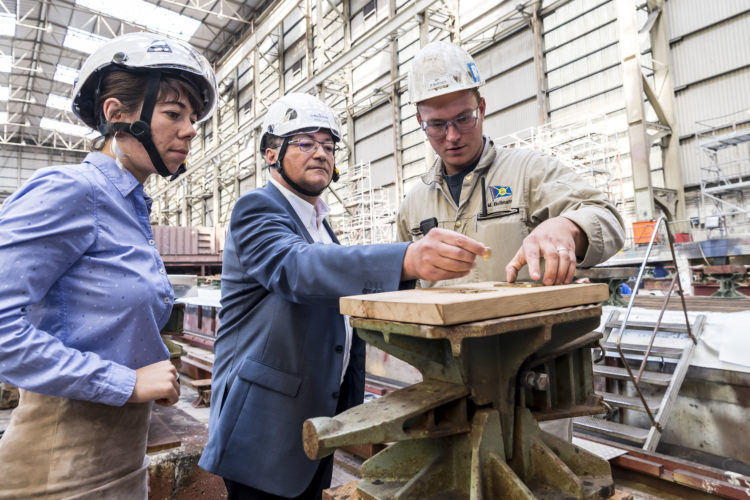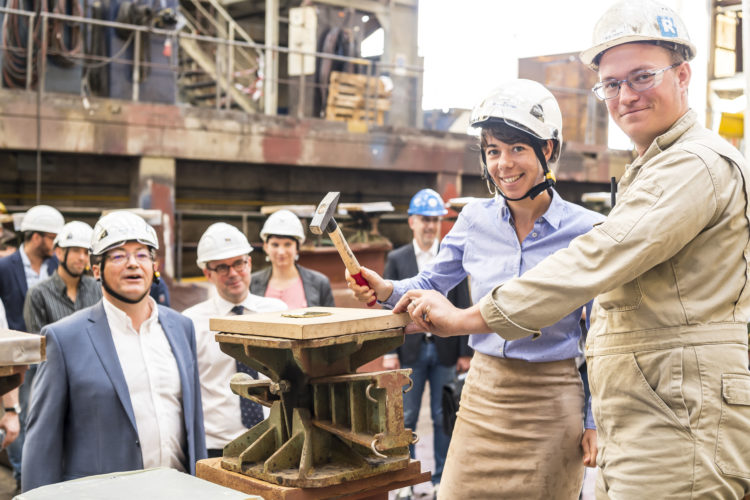Second construction milestone readies Brittany Ferries Honfleur for a more efficient future
-
 Naval architect Brice Robinson prepares the coin for Honfleur's keel laying ceremony
Naval architect Brice Robinson prepares the coin for Honfleur's keel laying ceremony
-
 Honfleur's first mate Fleur Le Derff and FSG head of building berth Michel Bollman at keel laying ceremony
Honfleur's first mate Fleur Le Derff and FSG head of building berth Michel Bollman at keel laying ceremony
-
 Honfleur hull design - wave modelling image
Honfleur hull design - wave modelling image
7 August 2018
· Traditional ‘coins in the keel’ ceremony takes place at shipyard
· Nautical ceremony dates back to Roman times
· Giant hull sections are craned into place on the slipway in Germany
This week Brittany Ferries celebrates the second milestone in the build of its next ship Honfleur. It’s a milestone which represents a leap forward in sustainable design, one that is at least as significant as the ship’s innovative LNG (liquefied natural gas) power deliver system.
Keel laying is the point at which the first hull blocks are lowered onto a slipway. After they are joined, Honfleur’s blocks will form a complete a hull that promises to glide through the seas far more efficiently than ships of the past. Fuel consumption will be lower and ride quality will be better for passengers.
“Technology has transformed the way we design hulls,” says Heike Billerbeck, head of ship theory and hydrodynamics at FSG, the German shipyard at which Honfleur is being built. “Over the last 20 to 30 years we’ve reduced wave resistance by between a third and a half.”
Heike and her team spent around three months creating a digital model of Honfleur’s hull, and testing it using computational fluid dynamic software.
This allowed them to visualise the size and angle of the bow wave and wake the ship will create: smaller waves mean less wasted energy. They also created animations of how Honfleur will perform in heavy seas as well as calculating exactly how much power Honfleur will need to sail at a given speed, ensuring she meets efficiency targets set by Brittany Ferries.
The shape of the hull – of which the keel is the very lowest beam running from bow to stern – has a huge impact on a ship’s manoeuvrability in port and its stability at sea. A good design reduces vibration that can sometimes be felt from the propeller which means Honfleur will be a more comfortable ship, as well as being better for the environment.
“Passengers will never see Honfleur’s hull, but they will certainly feel its benefit,” said Brice Robinson, Brittany Ferries naval architect, speaking from the keel laying ceremony. “Think of your car. It has been designed to slip through the air as cleanly as possible to maximise its fuel efficiency. The hull of a ship is just the same. It’s just a question of hydrodynamics rather than aerodynamics.”
The ‘coins in the keel’
The moment at which the keel is laid is marked by an ancient traditional coin-laying ceremony. This week, coins were placed in Honfleur’s keel by representatives of Brittany Ferries and FSG as a token of good fortune.
The origins of this tradition can be traced back to Roman times, when coins were placed into the mouths of soldiers killed in war in order to pay Charon, the mythological ferryman, to carry them across the River Styx.
In the past keel laying took on greater significance. For wooden ships, this was often the first time a vessel took physical shape. Now this happens with the earlier steel-cutting ceremony, after which a shipyard spends several months building huge sections of hull which are then craned onto a slipway, then welded together.
But the moment that the first of those steel sections is laid onto the slipway (from which Honfleur’s finished hull will be launched into the Baltic this December) remains an important moment.
For more visit the Honfleur website:
 News
News